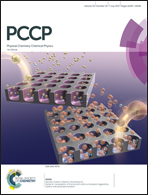Dynamic manipulation of the local pH within a nanopore triggered by surface-induced phase transition†
Abstract
Manipulating the local pH within nanoconfinement is essential in nanofluidics technology and its applications. Since the conventional strategy utilizes the overlapping of an electric double layer formed for charge compensation by protons near a negatively charged pore-wall surface, pH variation within a pore is limited to the acidic side. To achieve the variation at the alkaline side, we developed a system comprising a hydrophobic pore-wall surface and aqueous solution containing hydrophobic cations. Beyond a threshold cation concentration, a nanopore is filled with the second phase where the cations are remarkably enriched due to surface-induced phase transition (SIFT) originating from the hydrophobic effect. It is accompanied by the enrichment of coexisting anions. We experimentally show that pH in the second phase is much higher than in the bulk solution. Electrochemical measurements strongly suggest that the pH value can be increased from 4.8 to 10.7 within a 10 nm nanopore in the most significant case. This is ascribed to the enrichment of hydroxide anions. We argue that the extent and rate of pH variation are controlled as desired.



 Please wait while we load your content...
Please wait while we load your content...